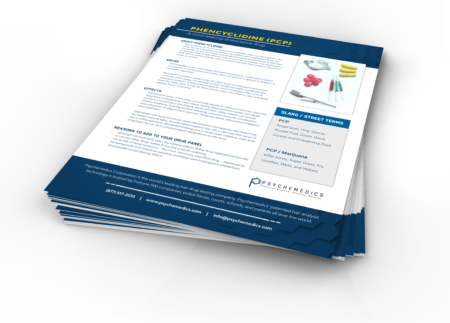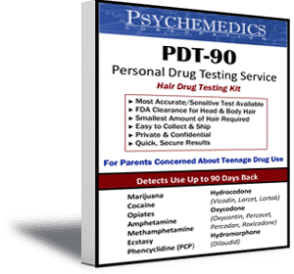COCAINE HAIR DRUG TESTING
The Era of "New Cocaine" Addicts More Quickly. Kills More Often.
What Is Cocaine?
Description
Cocaine is a highly addictive stimulant drug made from the leaves of the coca plant native to South America. It is a powerful stimulant and is one of the most addictive drugs. Cocaine is usually distributed as white powder, often diluted (“cut”) with a variety of substances, the most common being talcum, sugars and local anesthetics. This is done to stretch the amount of the product and increase profits for dealers. A cocaine hair drug testing program from Psychmedics will result in detection if abuse is occuring.
To increase profits or raise addictive potential, street dealers often add drugs such as amphetamines to cocaine. More recently, cocaine augmented with fentanyl has become a common street variety—Psychemedics calls this “New Cocaine” and is directly responsible for the significant increase in deaths by cocaine overdose.
Analyte
Benzoylecgonine — Main metabolite of cocaine
Cocaethylene — Produced when alcohol and cocaine taken together
Norcocaine — Minor metabolite of cocaine
Street Names / Slang Terms
Blow, Coke, Big C, Flake, Snow, Rock, Nose Candy, Crack
Contact Psychemedics Today
What Does It Look Like?
There are two main forms of cocaine.
A water-soluble hydrochloride salt is most familiar to recreational users as the white powder popular as a party drug. This powder is either inhaled nasally (snorted), rubbed into the gums, or dissolved in water to inject intravenously.
The base form of cocaine is created by processing the rock form of the drug with ammonia or sodium bicarbonate (baking soda) and water, then heating it to remove the hydrochloride to produce a smokable substance. The term crack is the street name given to freebase cocaine and the term “freebasing” refers to smoking the processed substance.
How is it Used?
The powder form of the drug is inhaled (snorted), rubbed on the gums or dissolved in water and injected.
Crack cocaine is the crystallized form and delivers a more potent, but shortlived high when smoked.
Cocaine is sometimes mixed with heroin or morphine and is called a "speedball".
Fast Facts About Cocaine
Why Choose Psychemedics For Cocaine Hair Drug Testing?
Unrivaled Detection. Nobody Is Better.
The “New Cocaine”, puts multiple generations at risk. With Illicitly Manufactured Fentanyl (IMF) readily available and inexpensive, dealers find a powerful profit motive to add it to cocaine. It delivers more punch, is highly addictive, and ensures repeat business.
But there is a tragic downside. Cocaine is still a favored “feel good” party drug. And a person may think they are getting cocaine but instead are getting a deadly combination of that drug plus fentanyl. Just a look at the rapidly rising numbers of hospital emergency room visits or deaths by cocaine underscore the seriousness of the threat.
Detection is the first step toward Deterrence. And Deterrence lowers the risks inherent with cocaine use.
Hydroxycocaines: Further Enhancing Cocaine Detection
Psychemedics was the first to introduce cocaine hair drug testing and add additional metabolic criteria to confirm cocaine use. While Psychemedics’ patented cocaine hair drug testing program is already the industry’s most accurate and sensitive, these unique cocaine markers provide an additional layer of drug detection science. While advancing the science at a time when deaths from cocaine overdose are at all time highs.
The science
When m-, p- and o-hydroxy derivatives of cocaine are found in certain ratios in extensively washed hair, they are indicative of cocaine ingestion. In light of metabolic variability among cocaine users, the ability to accurately measure the very low levels of these three additional cocaine metabolites can be a key to demonstrating usage of the drug.
Psychemedics has detected more drug users for more companies than any hair testing lab in the world and our results have been accepted by courts across the country. Contributing to our unmatched legal track record, it is the only hair test with safeguards validated by the FBI to protect those tested from false positive results by differentiating between ingestion versus external exposure to a drug. Our clients confidently make policy decisions knowing that we go the extra mile to ensure fairness to those tested.
Our non-invasive testing procedure uses a sample of hair that is up to 60% less than that required by any hair testing lab which is easily collected and shipped to our College of American Pathologists (CAP) and ISO-IEC 17025:2005 certified laboratory. Turnaround on most results is the best in the industry.
See the FBI's article from Journal of Analytical Toxicology

Hydroxycocaine metabolites as evidence of cocaine ingestion.
Psychemedics paper on the analysis of cocaine and metabolites in hair. Published in Analytical and Bioanalytical Chemistry.
More Information About Cocaine
Short Term Effects
Cocaine belongs to a class of drugs known as stimulants, which tend to give a temporary illusion of limitless power and energy that leave the user feeling depressed, edgy, and craving more. When ingested, it stimulates the central nervous system and increases energy while raising heart rate and blood pressure. It is considered a “feel-good” drug and is often favored for its tendency to enable partiers to stay awake and active for long hours.
While cocaine’s effect is rapid, it quickly abates and leaves the body. Not surprisingly, the faster the drug is absorbed, the more intense the resulting high, but the effect is short lived. Within a few minutes of snorting cocaine a person feels a euphoric rush and excitability that can peak within 20-40 minutes. Conversely, smoking the altered cocaine known as crack can bring on extremely intense effects within a few seconds, but peaking in as little as five minutes. The short duration of the high often leads users to binge in an attempt to prolong the effect.
While cocaine brings on euphoric effects, it also brings with it a host of physiological effects that can be detrimental over time. Short-term physiological effects of cocaine use include constricted blood vessels; dilated pupils; and increased body temperature, heart rate, and blood pressure.
Long Term or Extreme Effects
While the drug is preferred by recreational users for its euphoric effect, some cocaine users report experiencing anxiety, restlessness, irritability, anxiety, panic, and even paranoia. These effects manifest themselves in behaviors that are erratic and indicators of usage. Some users may also experience tremors or muscle twitches sometimes referred to as being “wired”.
High doses can lead to side effects including hostility, anger, or other negative and aggressive behaviors. Habitual users can experience paranoia, anxiety, anger, and hallucinations. All are indicative of long-term use.
For habitual or high dosage cocaine users, significant medical issues are not uncommon. The most frequent are cardiovascular events, including disturbances in heart rhythm and heart attacks. Beyond cardiovascular risks, habitual users also risk neurological effects, including headaches, seizures, strokes, and coma.
In extreme and rare cases, first-time users have died as a result of the physiological changes cocaine brings.
Stay Current On Drugs Of Abuse
We have put together an information sheet on Cocaine to help you understand the threats and recognize the symptoms of abuse. You can download the document for your reference or to share with others who may benefit from the information we have shared.


Buy Our PDT-90 AT Home Drug Testing Kit Today
Parents can administer the test in the privacy of their own homes. Just collect a small sample of a child’s hair, send the sample to the Psychemedics laboratory and receive notification of the results within 3-5 business days of receipt of the sample at the laboratory. The ‘PDT-90’ includes all instructions plus a pre-paid mailing envelope for the sample. No names are used so complete confidentiality is assured.
$89.95 - Plus Free Shipping
Drug News You Can Use
Sign up for our quarterly newsletter to stay up-to-date with snapshots of usage statistics, information on the latest trends, and updates on detection science.



